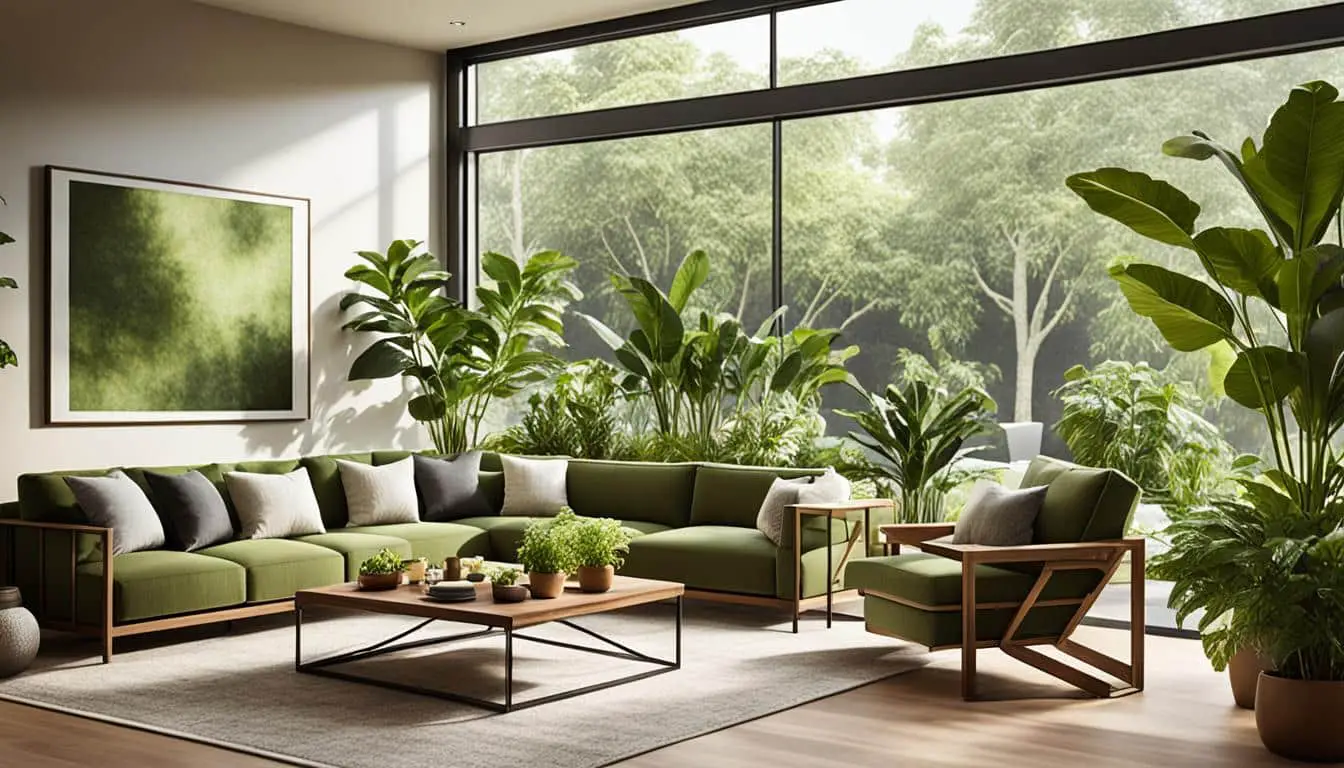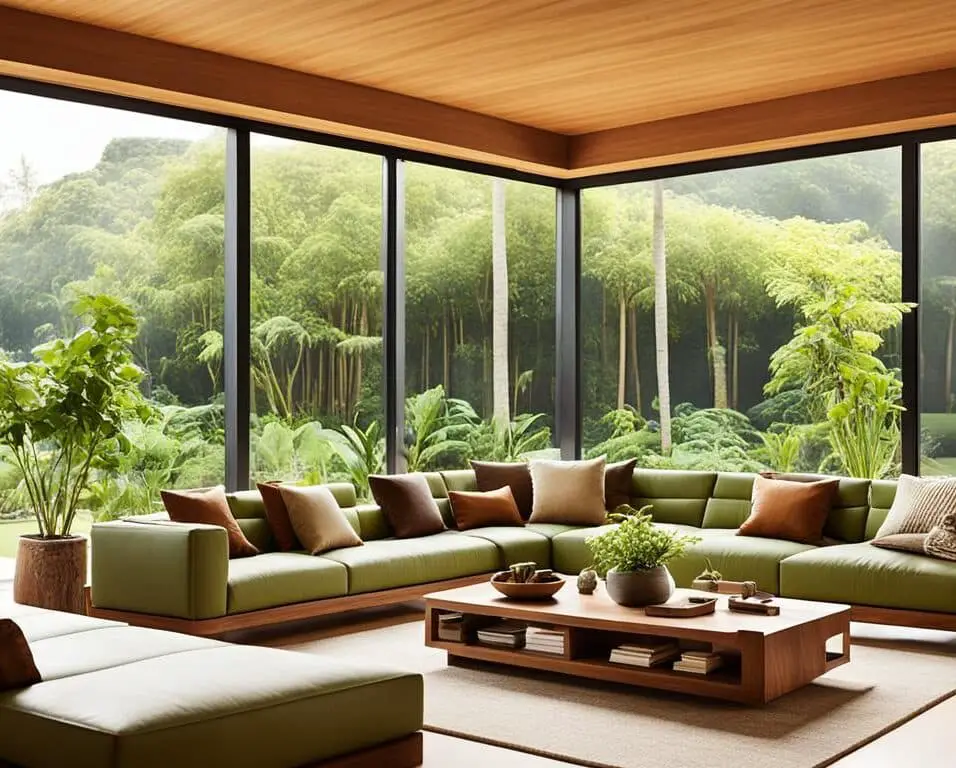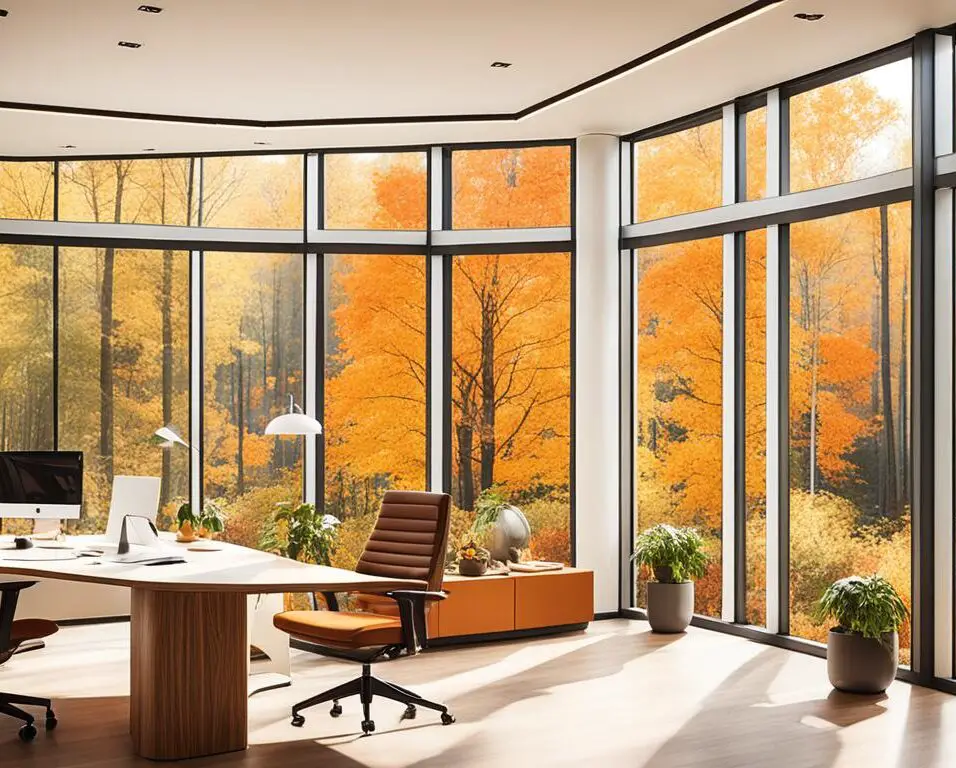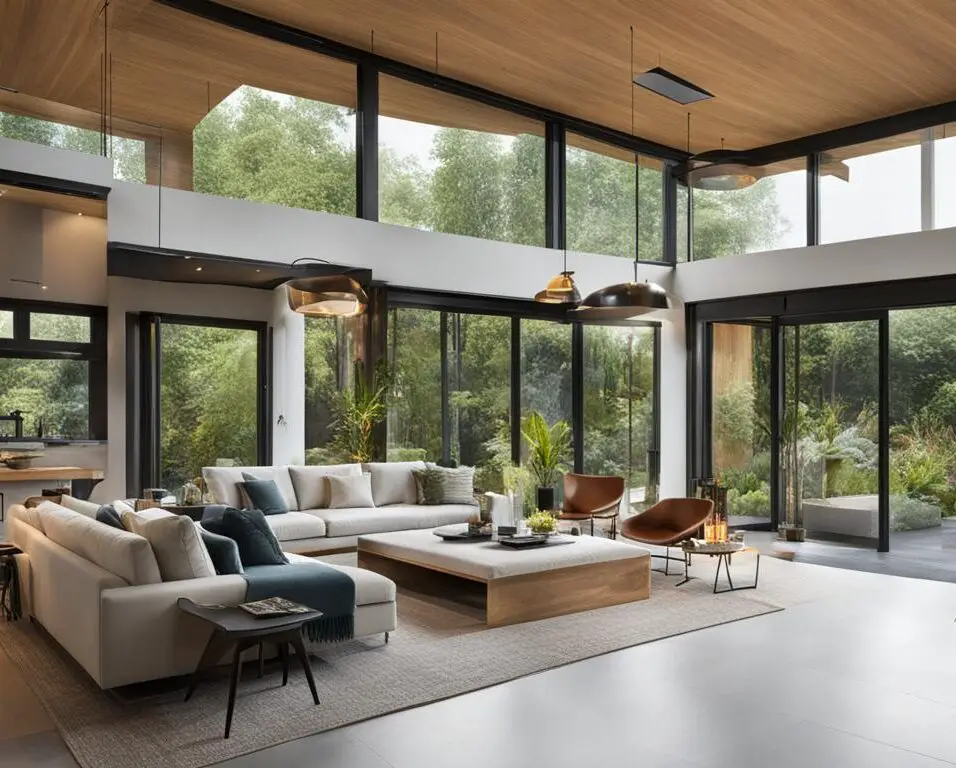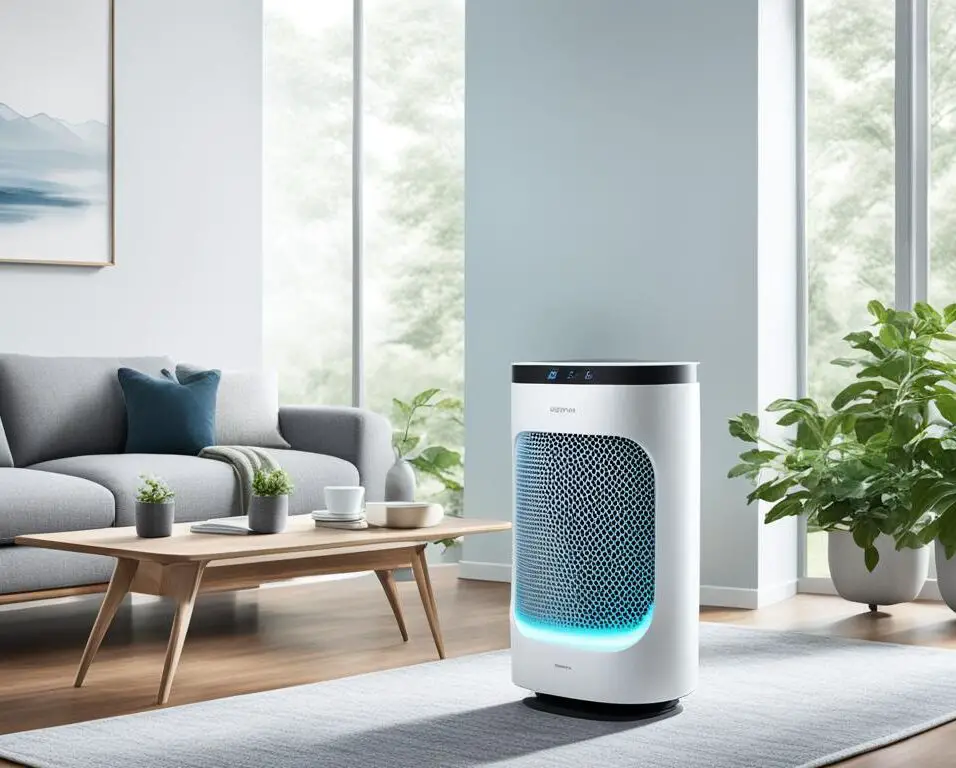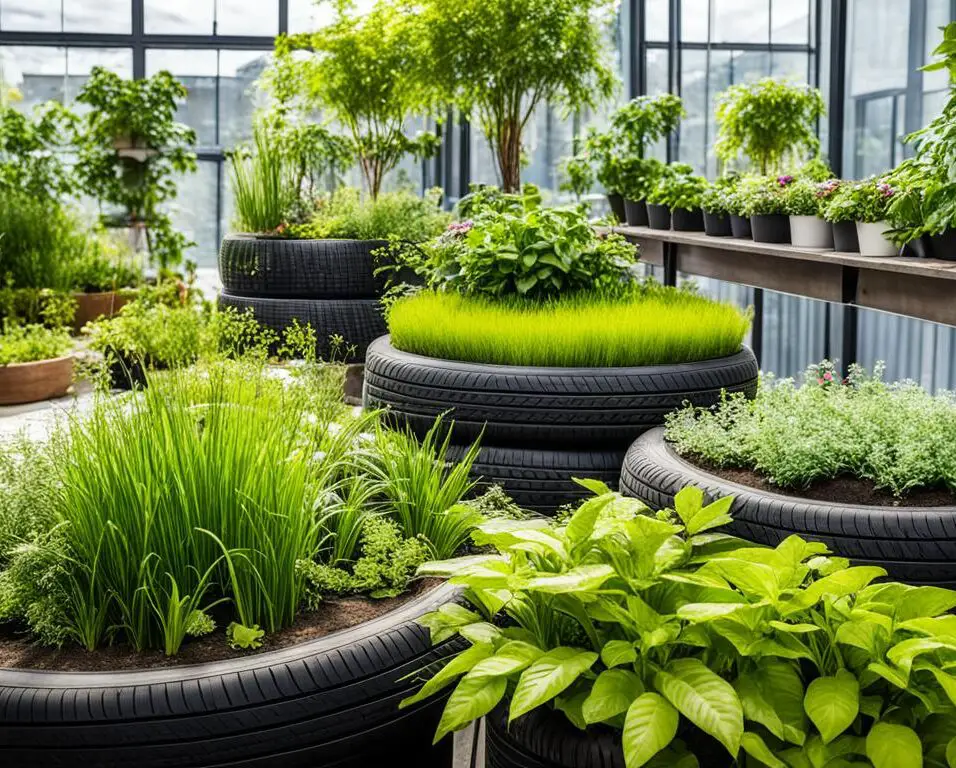The Role of Plants in Interior Biophilic Design
As an experienced interior designer, I have witnessed the transformative power of plants in creating greener and more inviting indoor spaces. In the realm of interior biophilic design, incorporating plants into our living and working environments is not just a trend, but a science-backed approach to enhancing our overall well-being. By bringing nature indoors, we can create spaces that not only look beautiful but also have a positive impact on our health and happiness.
Interior biophilic design embraces the concept of reconnecting with nature by integrating natural elements, such as plants, into interior spaces. This approach recognizes our innate desire for connection with the natural world, even in urban environments where greenery may be scarce. With plants, we can bring vitality, freshness, and a touch of tranquility to our interiors.
One of the remarkable benefits of plants in interior biophilic design is their ability to improve air quality. Plants act as natural air purifiers, removing toxins and releasing oxygen into the environment. This not only creates a healthier indoor atmosphere but also helps to reduce stress levels and increase productivity. By providing a connection to nature, plants have been proven to enhance our mood, promote a sense of well-being, and even improve cognitive function.
But the benefits of plants extend beyond their purifying abilities. They also have a positive impact on acoustics, absorbing noise and creating a more peaceful and serene environment. In workspaces, the presence of plants has been linked to increased creativity and focus, making them a valuable addition to offices and co-working spaces. Furthermore, plants add a touch of natural beauty, softening the harsh lines of modern architecture and infusing spaces with warmth, color, and texture.
Key Takeaways:
- Interior biophilic design incorporates plants and other natural elements into indoor spaces to enhance well-being and create a connection with nature.
- Plants improve air quality, reduce stress levels, and increase productivity in interior spaces.
- They also enhance acoustics, add aesthetic value, and create a sense of tranquility.
- Popular indoor plants for biophilic design include pothos, spider plants, snake plants, and peace lilies.
- Proper maintenance and care are crucial for the health and longevity of plants in interior biophilic design.
Benefits of Plants in Interior Biophilic Design
Plants play a vital role in interior biophilic design, offering a multitude of benefits that enhance both our well-being and the aesthetics of our indoor spaces. By incorporating plants into interior design, we can create a harmonious environment that fosters a stronger connection with nature and promotes a sense of tranquility and vitality.
A Healthier Indoor Environment
One of the key benefits of plants in interior biophilic design is their ability to improve air quality. Plants act as natural air filters, removing pollutants and toxins from the air and releasing oxygen as a byproduct. This purification process contributes to a healthier indoor environment, reducing the risk of respiratory issues and promoting overall well-being.
Promoting Mental Well-being and Stress Reduction
The presence of plants in interior spaces has been proven to have a positive impact on mental health and well-being. Research shows that being surrounded by plants can help reduce stress levels, enhance mood, and improve cognitive function. Incorporating plants into interior design creates a connection with nature, offering a calming and rejuvenating atmosphere that promotes relaxation and mental clarity.
Acoustic Improvement and Increased Productivity
In addition to their visual appeal, plants also contribute to improved acoustics in interior spaces. The leaves and branches of plants serve as natural sound absorbers, helping to reduce noise levels and create a more peaceful environment. This acoustic improvement enhances productivity and focus in workspaces, fostering a conducive atmosphere for creativity and concentration.
Enhanced Aesthetics and Sense of Liveliness
Plants add a touch of natural beauty and color to interior spaces, creating a visually appealing environment that showcases the wonders of nature. The vibrant greenery of plants brings life to any room, instilling a sense of warmth and serenity. Whether it’s a lush green wall or a carefully placed potted plant, the presence of plants in interior design enhances aesthetics and creates a welcoming and inviting atmosphere.
Benefits of Plants in Interior Biophilic Design
| Benefits | Description |
|---|---|
| Improved Air Quality | Plants remove toxins and release oxygen, creating a healthier indoor environment. |
| Stress Reduction | Being surrounded by plants promotes mental well-being, reduces stress levels, and enhances cognitive function. |
| Acoustic Improvement | Plants serve as natural sound absorbers, reducing noise levels and improving overall acoustics. |
| Increased Productivity | The calming presence of plants in workspaces enhances focus, creativity, and productivity. |
| Enhanced Aesthetics | Plants add natural beauty, color, and vibrancy to interior spaces, creating a sense of liveliness. |
Types of Plants Suitable for Interior Biophilic Design
When it comes to interior biophilic design, selecting the right plants is crucial for creating a harmonious and green space. The right combination of plants can not only enhance the aesthetic appeal but also contribute to the overall well-being of the occupants. Here are some popular types of plants that are suitable for interior biophilic design:
- Pothos: Known for its air-purifying qualities, pothos is an excellent choice for indoor spaces. It thrives in low light conditions and requires minimal maintenance.
- Spider Plants: These resilient plants adapt well to a variety of indoor environments. They are known for their ability to remove toxins from the air, making them a popular choice for interior spaces.
- Snake Plants: Snake plants, also known as mother-in-law’s tongue, are known for their ability to improve air quality by converting carbon dioxide into oxygen. They are low-maintenance and can tolerate a wide range of light conditions.
- Peace Lilies: Peace lilies are not only beautiful with their elegant white flowers but also have air-purifying properties. They thrive in low light conditions and are easy to care for.
In addition to these popular options, there are other types of plants that can be incorporated into interior spaces, depending on factors such as light levels, humidity, and maintenance requirements. Some suitable options include succulents, ferns, and orchids. It’s important to consider the specific needs of each plant and the overall design aesthetic when selecting plants for interior biophilic design.
Benefits of Plants in Interior Biophilic Design – A Quick Recap:
- Improved air quality through the removal of toxins and production of oxygen.
- Reduced stress levels and enhanced mental well-being through a connection to nature.
- Improved acoustics and noise reduction in workspaces.
- Increased productivity and creativity.
- Enhanced aesthetics, creating a sense of warmth and liveliness.
| Plant | Air-Purifying Qualities | Light Requirements | Maintenance Level |
|---|---|---|---|
| Pothos | Yes | Low light | Low maintenance |
| Spider Plants | Yes | Medium light | Low maintenance |
| Snake Plants | Yes | Low to bright light | Low maintenance |
| Peace Lilies | Yes | Low light | Low maintenance |
| Succulents | No | Bright light | Low maintenance |
| Ferns | No | Medium to bright light | Moderate maintenance |
| Orchids | No | Bright light | Moderate maintenance |
These plants offer a range of benefits, from air purification to visual appeal, bringing nature indoors and creating a healthier and more inviting space.
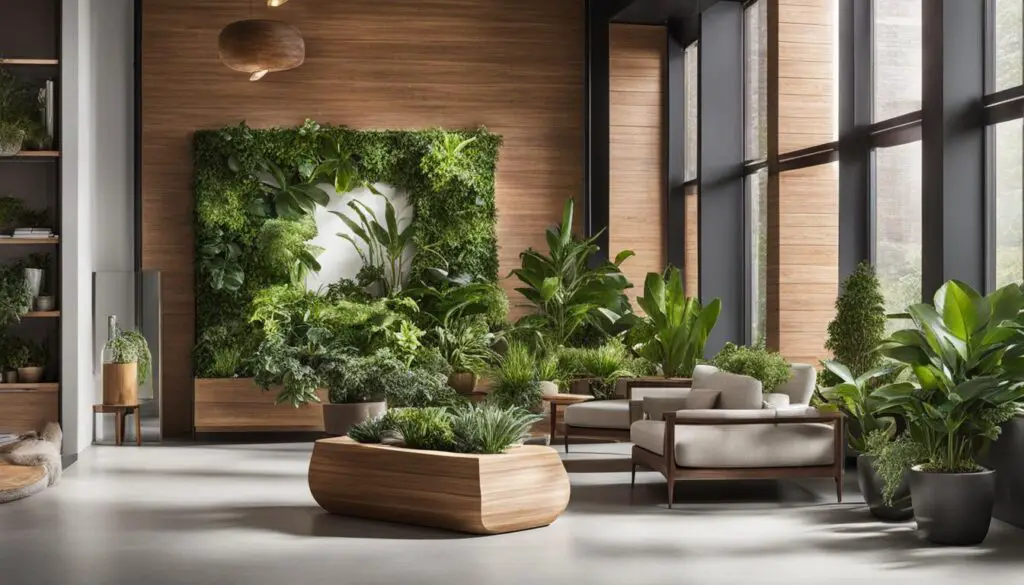
Incorporating Plants in Interior Biophilic Design
When it comes to interior biophilic design, incorporating plants is a key element in creating a harmonious and rejuvenating space. There are numerous ways to integrate plants into your interior design, each offering its unique aesthetic appeal and benefits. Whether you prefer a vertical garden or strategically placed planters and pots, incorporating plants can transform any space into a greener and more vibrant environment.
One popular approach to incorporating plants is by creating green walls or vertical gardens. This involves mounting plants on walls to create a lush, vertical display. Not only does it add a stunning visual element to the room, but it also maximizes the use of space, making it perfect for smaller areas. Green walls offer a striking focal point and bring a touch of nature indoors.
Another option is to strategically place planters and pots throughout the space. This allows you to add greenery to shelves, tables, or even hanging from the ceiling, depending on the design aesthetic and layout of the room. Using different pot sizes and plant varieties can create a diverse and visually appealing arrangement. This approach gives you the flexibility to easily change the placement of plants as needed.
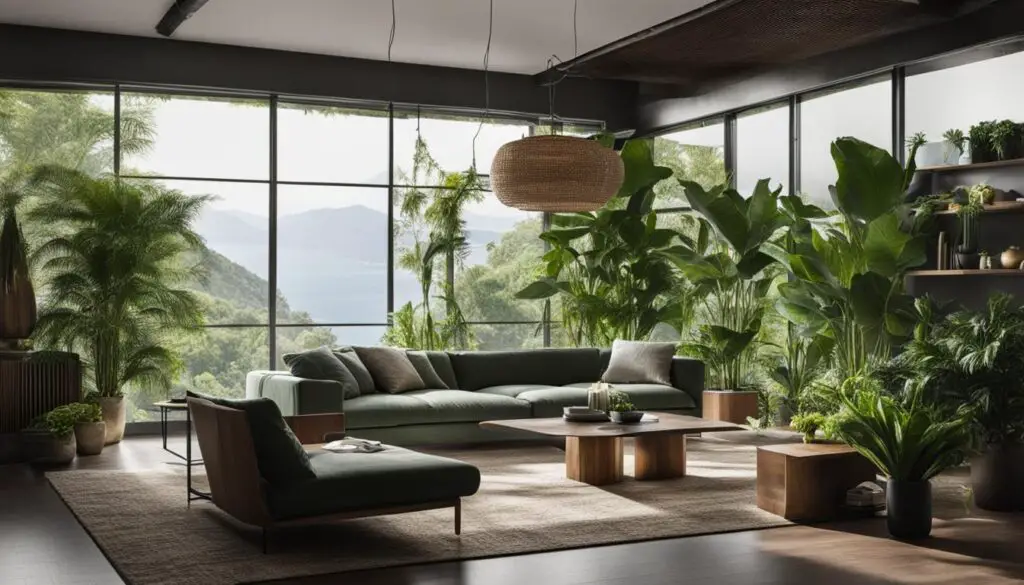
When incorporating plants, it is important to consider the specific needs of the plants and ensure they are well-suited to the interior environment. Factors such as light levels, humidity, and maintenance requirements should be taken into account when selecting the right plants for your space. By choosing plants that thrive indoors and complement the overall design aesthetic, you can create a harmonious balance between nature and interior decor.
Benefits of Incorporating Plants in Interior Biophilic Design
The benefits of incorporating plants into interior biophilic design are numerous. Not only do they add an aesthetic appeal, but they also offer various health and well-being benefits. Here are some key advantages:
- Improved air quality: Plants naturally filter and purify the air, removing toxins and releasing oxygen, which improves the overall air quality and creates a healthier indoor environment.
- Stress reduction: The presence of plants has a calming effect, reducing stress levels and promoting a sense of well-being and relaxation.
- Enhanced focus and productivity: Studies have shown that having plants in the workspace can increase focus and productivity, leading to improved performance and creativity.
- Visual appeal: Plants add a touch of nature, softness, and color to any interior space, creating a visually appealing and inviting ambiance.
Incorporating plants into interior biophilic design is not only aesthetically pleasing but also contributes to the overall health and well-being of occupants. By carefully selecting and integrating plants into the design, you can create a harmonious and rejuvenating space that brings the benefits of nature indoors.
Comparison of Different Ways to Incorporate Plants
| Method | Advantages | Disadvantages |
|---|---|---|
| Green walls or vertical gardens |
|
|
| Planters and pots |
|
|
Maintenance and Care for Plants in Interior Biophilic Design
Proper maintenance and care are crucial for ensuring the health and longevity of plants in interior biophilic design. By providing the right amount of light, water, and humidity, along with regular pruning and leaf cleaning, you can create an optimal environment for your green companions. Monitoring plants for signs of pests or diseases is also essential, as timely intervention can prevent any potential damage. Remember to take appropriate action if needed, such as using natural pest control methods or seeking professional advice. Furthermore, regular fertilizing and repotting should be considered to promote optimal growth and ensure thriving plants in your interior spaces.
Key Practices for Plant Maintenance:
- Ensure proper lighting conditions: Different plants have varying light requirements, so it’s important to place them in appropriate spots to help them thrive. Monitor the amount of natural or artificial light they receive and adjust accordingly.
- Monitor watering needs: Overwatering or underwatering plants can be detrimental to their health. Understand the specific watering needs of each plant and maintain a consistent watering schedule, taking into account factors such as humidity levels and the season.
- Promote humidity when necessary: Some plants thrive in humid conditions, and providing the right level of humidity can contribute to their well-being. Consider using a humidifier or placing a tray of water near plants that require higher humidity.
- Regular pruning and leaf cleaning: Pruning helps maintain the shape and size of the plants, while leaf cleaning removes dust and enhances their appearance. It’s recommended to regularly inspect and prune plants to eliminate dead or damaged parts and clean the leaves gently to prevent dust buildup.
- Monitor and address pests and diseases: Regularly inspect plants for signs of pests or diseases, such as yellowing leaves, spots, or unusual growth patterns. If detected, promptly take appropriate action using natural remedies or consult with a professional to ensure effective treatment.
- Apply appropriate fertilization: Providing plants with essential nutrients through fertilization is vital for their growth. Research and apply suitable fertilizers based on the specific needs of each plant, considering factors like soil type and growth stage.
- Repot plants when needed: As plants grow, they may outgrow their pots and require repotting. Check the roots periodically and transfer the plant to a larger pot if necessary, using proper soil and ensuring adequate drainage.
By following these maintenance and care practices, you can create a nurturing environment for your plants, allowing them to thrive and contribute to the beauty and well-being of your interior biophilic design.
Case Studies of Successful Interior Biophilic Design
Case studies provide valuable insights into the impact of incorporating plants into interior biophilic design. These real-life examples demonstrate how the integration of plants can transform spaces, improve air quality, and enhance the well-being of occupants. Let’s explore some noteworthy case studies:
Case Study 1: Office Spaces with Green Walls
In a bustling corporate environment, green walls have proved to be game-changers. Office spaces like XYZ Corporation have successfully implemented vertical gardens as part of their interior biophilic design. These lush displays not only add natural beauty but also contribute to increased productivity and employee satisfaction. The combination of vibrant greenery and a calming atmosphere has created a more inviting and refreshing workspace.
Case Study 2: Healthcare Facilities with Natural Elements
Healthcare facilities, such as ABC Hospital, have embraced the principles of interior biophilic design to create healing environments. By incorporating natural elements, including plants, these facilities have witnessed significant positive outcomes. Patients in these spaces experience reduced stress levels and improved well-being, leading to enhanced recovery and overall satisfaction. The presence of greenery brings a sense of tranquility and promotes a soothing ambiance that can positively impact patients’ physical and mental health.
These two case studies are just a glimpse of the success achieved through interior biophilic design. They underline the immense potential of plants in transforming indoor spaces and improving the well-being of the people who inhabit them.
Benefits of Interior Biophilic Design in Case Studies
| Case Study | Benefits |
|---|---|
| Office Spaces with Green Walls |
|
| Healthcare Facilities with Natural Elements |
|
The real-world application of interior biophilic design has proven to be highly beneficial in various contexts, from corporate offices to healthcare settings. These case studies solidify the importance of incorporating plants into interior spaces and highlight the positive impact on individuals’ well-being and overall experience.
Conclusion
The incorporation of plants in interior biophilic design has proven to have a significant impact on the overall well-being and aesthetic appeal of indoor spaces. By introducing greenery into our environments, we create a harmonious connection with nature, resulting in greener, more vibrant spaces that promote a sense of tranquility and rejuvenation.
Not only do plants enhance the visual appeal of interior spaces, but they also offer a range of benefits. Through their natural ability to purify the air, plants contribute to improved indoor air quality, creating a healthier environment for occupants. Furthermore, the presence of plants has been found to reduce stress levels and enhance productivity, making them ideal for a variety of settings, including homes, offices, and healthcare facilities.
When it comes to interior biophilic design, careful consideration must be given to plant selection, maintenance, and integration. Choosing the right plants that are adaptable to the indoor environment is crucial for their health and longevity. Additionally, regular care and maintenance, such as providing adequate light, water, and pruning, are essential for promoting optimal growth.
In conclusion, interior biophilic design presents a transformative approach to creating spaces that prioritize human well-being and connection with nature. By incorporating plants into our indoor environments, we can elevate the quality of our surroundings, improve our overall health and productivity, and foster a greater sense of harmony within our daily lives.
FAQ
What is interior biophilic design?
Interior biophilic design incorporates natural elements, such as plants, into indoor spaces to enhance wellbeing and create a connection with nature.
What are the benefits of plants in interior biophilic design?
Plants improve air quality, reduce stress levels, increase productivity, and enhance overall satisfaction in interior spaces. They also improve acoustics, reduce noise levels, and enhance aesthetics.
What types of plants are suitable for interior biophilic design?
Popular options for interior biophilic design include pothos, spider plants, snake plants, and peace lilies, which are known for their air-purifying properties and adaptability to low light conditions. Other options include succulents, ferns, and orchids.
How can I incorporate plants into interior biophilic design?
You can create green walls or vertical gardens by mounting plants on walls. You can also use planters and pots to strategically place plants throughout the space, adding greenery to shelves, tables, or hanging from the ceiling.
How do I maintain and care for plants in interior biophilic design?
Proper maintenance involves providing the right amount of light, water, and humidity, as well as regular pruning and cleaning of leaves. Monitoring for pests or diseases and taking appropriate action is important. Regular fertilizing and repotting should also be considered.
Are there any successful case studies of interior biophilic design?
Yes, there are numerous case studies showcasing the positive impact of incorporating plants into interior spaces. Examples include increased productivity and employee satisfaction in offices with green walls, and reduced stress and improved patient outcomes in healthcare facilities with natural elements.
What is the role of plants in interior biophilic design?
The role of plants in interior biophilic design is to create greener, more vibrant environments that improve air quality, reduce stress levels, increase productivity, and enhance overall well-being.



